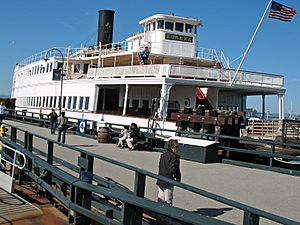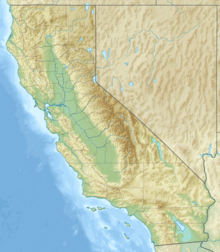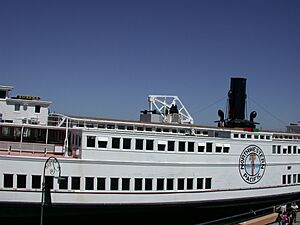Eureka (ferryboat) facts for kids

Eureka docked at Hyde Street Pier
|
|
| History | |
|---|---|
| Name |
|
| Builder | San Francisco and North Pacific Railroad, Tiburon, California |
| In service | 1890-1958 |
| Refit | 1920-22 |
| Status | Museum ship |
| General characteristics | |
| Type | Steamboat |
| Tonnage | 2,420 GT |
| Length | 299 ft 6 in (91.29 m) LOA |
| Beam | 78 ft (24 m) |
| Propulsion | 1 × 1,500 hp (1,119 kW) walking beam engine |
| Capacity |
|
|
Eureka (double-ended ferry)
|
|

View from port stern
|
|
| Location | San Francisco, California |
| Built | 1890 |
| NRHP reference No. | 73000229 |
| Significant dates | |
| Added to NRHP | April 24, 1973 |
| Designated NHL | February 4, 1985 |
The Eureka is a historic paddle steamboat built in 1890. Today, you can visit this amazing ship at the San Francisco Maritime National Historical Park in San Francisco, California. It was first called Ukiah, named after a city where the railway had recently expanded. The San Francisco and North Pacific Railroad Company built the boat at their yard in Tiburon. The Eureka is a very important ship. It has been named a National Historic Landmark.
It is also the largest existing wooden ship in the world!
Contents
Meet the Eureka!
The Eureka is a special ferryboat with a long history. It was built over 130 years ago. This ship helped connect people and goods across the San Francisco Bay. Today, it serves as a floating museum. It teaches us about travel and life in the past.
A Busy Start: Ferrying People and Trains
When it was first built, the ship carried people between San Francisco and Tiburon during the day. At night, it moved railroad freight cars. This made it a very busy and important part of transportation.
In 1907, the Ukiah had a small accident. It sank at East Street in San Francisco because of issues while unloading railroad cars. Luckily, it was later raised and put back into service. That same year, its new owners, the Northwestern Pacific Railroad, changed its route. It started sailing between Sausalito and the San Francisco Ferry Building.
As more people started using cars, they wanted to drive across the bay. There were no bridges over San Francisco Bay yet. So, the Ukiah was changed to help. Its lower deck was rebuilt to carry vehicles. The deck above, which was also enclosed, was made bigger for more passengers.
A New Name and a Big Rebuild
During World War I, the Ukiah played a role in the war effort. It carried rail cars filled with ammunition. Carrying such heavy loads caused a lot of stress on the ship's hull. The government decided to pay for a complete rebuilding of the ship.
Skilled shipwrights worked for two years on the ferry. They replaced almost all of its structure above the waterline. This type of major reconstruction was sometimes called "jacking up the whistle and sliding a new boat underneath."
After its big rebuild, the ferry was given a new name: Eureka. This name honored the Northern California city. It was also the new northern end of the Northwestern Pacific Railroad line.
As the Eureka, it could carry 2,300 passengers and 120 automobiles. At that time, it was the largest and fastest double-ended passenger ferry boat in the world. It was about 299 feet long and 78 feet wide.
Life as a Commuter Ferry
Between 1922 and 1941, the Eureka was a key part of the Sausalito commuter route. As the biggest boat for the Northwestern company, it handled the busiest trips. This included the 7:30 AM trip from Sausalito and the 5:15 PM trip from San Francisco. Each of these trips often carried about 2,200 passengers.
During this time, the upper deck of the Eureka was very comfortable. It had seating areas, a magazine stand, and even a restaurant that served full meals.
While it could carry cars, the Eureka was mostly a passenger boat. It carried very few cars on its regular runs. However, after 1929, it sometimes made extra trips from the Hyde Street Pier in San Francisco. On Sundays, these trips would carry automobiles.
The End of an Era
The completion of the Golden Gate Bridge in 1937 changed everything for ferry services. This bridge connected San Francisco and Marin, making it easier to cross the bay by car. The Northwestern Pacific company first reduced its ferry services. Then, in 1941, they stopped using ferries completely.
During the war years, the Eureka helped transport troops. It joined other bay ferries to move soldiers from Camp Stoneman to the piers in San Francisco.
By the 1950s, the Eureka was linking Southern Pacific's cross-country trains. These trains ended in Oakland, and the Eureka would carry passengers to San Francisco. This service continued until 1957. That year, the ship's engine broke a crank pin. The ferry service was then stopped the following year. In 1958, the Eureka became part of the historic ship collection. It is now at the National Historical Park.
In the late 1990s, the Eureka was even used as a main filming location for the TV show Nash Bridges.
In October 1999, the Eureka went into drydock for a big restoration project. This $1 million project focused on the ship's superstructure. These are the parts of the vessel that are above the water. A major part of this work was replacing the boat's "kingposts." These are four large wooden structures that support the paddlewheels and upper decks.
How the Eureka Was Designed
Many large ferryboats still exist in the United States. However, the Eureka is special because it is the only one with a wooden hull. It is a great example of traditional American wooden shipbuilding.
Underneath its upper decks, the hull is 42 feet wide and 277 feet long. The main cabin structure sits on a platform. This platform extends 18 feet from the hull on each side.
The ship's walking beam engine was first powered by coal-fired boilers. In 1905, these were changed to use oil. The Fulton Iron Works in San Francisco built the engine in 1890. It is the only walking beam engine in the United States that is still preserved in a floating vessel.
With its increased length, the Eureka became the largest wooden passenger ferry ever built. It was certified to carry 3,500 people.
Images for kids





